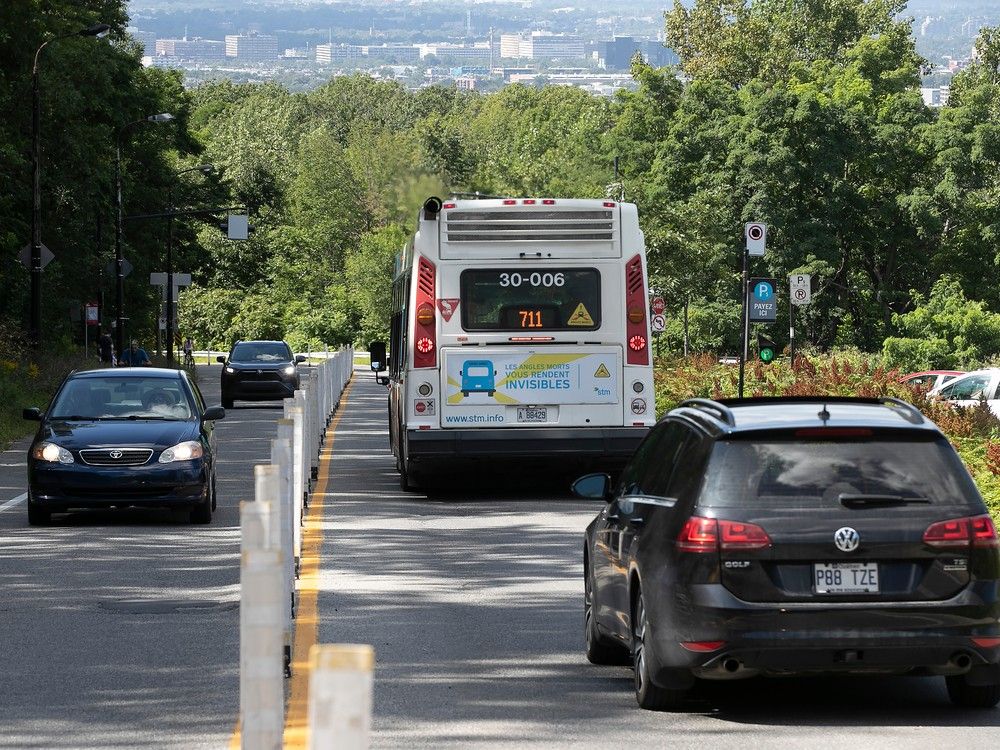The city of Montreal has been quietly working on a new mobility plan for Camillien-Houde Way that could include banning cars and trucks, but the fire department is concerned that barring emergency vehicles from that segment of the through road on Mount Royal could endanger the public, an internal document obtained by the Montreal Gazette reveals.
We apologize, but this video has failed to load.
The city manager’s office mandated the municipal urban planning and mobility department to examine a proposal to turn Camillien-Houde into a bike- and pedestrian-only route, the six-page document, dated May 24, indicates. It offers the fire department’s analysis of the impact on emergency response times if firefighters, who respond to medical emergencies as first responders and carry out rescue operations as well as fight fires, can’t use the road to reach the mountain from one end of the only through road.
This advertisement has not loaded yet, but your article continues below.
“After reflection, maintaining the Camillien-Houde route is to be prioritized,” the fire department says in response to a question from the urban planning and mobility department asking how the fire department can alter its access strategy and its risk-coverage plan to maintain current response times if the road is no longer fully accessible to fire trucks.
Asked about the possible impact on emergency interventions, including technical rescues and reaching accidents in remote areas, the fire department responds: “The impacts are the response time and getting to a user requiring assistance from an emergency service.”
“The option of closing the Camillien-Houde route is one of the scenarios under study,” Catherine Cadotte, a spokesperson for the mayor’s office, said in a written response. Not all scenarios involve barring vehicles, she said.
“The scenarios that are being considered are being analyzed by several city departments, including the (fire department). What is clear is that the option chosen will meet the three priorities set out by the administration from the start: safe travel, protection of the environmental value of the mountain and access to it. Our administration makes no compromises on the safety of Montrealers and we look forward to presenting the chosen scenario this fall.”
This advertisement has not loaded yet, but your article continues below.
Camillien-Houde starts on the east side of the mountain, where Mont-Royal Blvd. and Mont-Royal Ave. meet. The name of the two-way road that crosses Mount Royal changes to Remembrance Rd. at about its midpoint, in front of the entrance of Mount Royal Cemetery.
The document indicates that the proposal given to the fire department to analyze is to have all vehicles, including emergency vehicles, use Remembrance — which begins at Côte-des-Neiges Rd. on the west side — to reach the mountain.
However, the proposal would complicate rescue operations to reach injured cyclists, pedestrians and skiers, the fire department states.
“In the event that we have no means of access to the Camillien-Houde route, firefighters will have to leave their vehicle at the bottom or at the top of the road and complete the route on foot with the equipment on their shoulders in order to get to the user waiting for assistance. Moreover, the person will also have to be brought back (this way) to bring him to the ambulance and transport him from there. It should be noted that the client experience is not optimal.”
This advertisement has not loaded yet, but your article continues below.
The greatest impact of closing Camillien-Houde would be on emergency response to municipal facilities on Mount Royal, such as the belvedere, the Smith House and the chalet at Beaver Lake, the document says. Travel times in the areas around Mount Royal wouldn’t be affected by the closure of Camillien-Houde, it adds, but it would require a “significant change” in how fire stations respond to emergency calls in the future.
In several scenarios, the response times from different stations would increase by almost one minute and by as much as 98 seconds, the document indicates.
“According to our studies, there will be an increase in our travel times, without knowing what the impact will be of having a single access to Mount Royal for users,” the fire department says of having only Remembrance to reach the mountain alongside private vehicles.
“An increase in traffic jams is to be expected. The possible repercussions will be felt by your users requiring emergency service assistance.”
The city’s proposal presents three options: the status quo, which means leaving Camillien-Houde open; creating a six-metre-wide emergency lane that would be cleared in winter on an otherwise bike- and pedestrian-only Camillien-Houde; and closing Camillien-Houde to all vehicles.
This advertisement has not loaded yet, but your article continues below.
The fire department says it recommends the first option, leaving Camillien-Houde open to vehicles, “for better access.”
If the city opts to change to a bike- and pedestrian-only Camillien-Houde, the department says the emergency lane is necessary. Moreover, “it would be important that it be cleared of snow and that the width be a minimum of six metres to allow a vehicle to cross paths with pedestrians, even if there are snowbanks.”
The document sender is a deputy director of the fire department and the recipient is fire chief Richard Liebmann. It’s unclear who at the city received the fire department’s analysis.
Recommended from Editorial
This advertisement has not loaded yet, but your article continues below.

